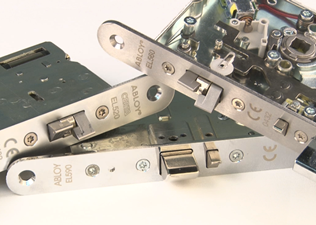Setting the standard
Setting the standard
Do your installed or specified products meet the highest standards?
The recent introduction of mandatory CE marking has helped to ensure all door security products in the EU meet minimum standards, however specifiers should not rely on the symbol as a sign of quality. Here, Jon Burke, Marketing Manager of Abloy UK, warns about the false sense of security CE marks provide, and advises specifiers to use only trusted brands to avoid dangerous and sometimes illegal installations.
Last year saw mandatory CE marking for all construction products in the EU added to the Construction Products Directive. Now, under the Construction Products Regulation (CPR), it is a legal requirement for UK manufacturers of construction products to apply CE marking to any of their products, which are covered by Harmonised European Standards (hENs).
CE marking is an indication of a product’s compliance with EU legislation, enabling them to be traded within the European market. However, a common misconception is that a CE mark guarantees that a product is of a very high quality.
Quality control
If a product features a CE mark, it means it has met the minimum standards required, but that does not guarantee it will perform to the highest standard. For example, a lock CE marked to EN12209 only has to achieve the minimum performance levels of between two and four on the 11-digit classification scale for durability and fire performance.
For suppliers and manufacturers, the CE mark is there to offer protection from prosecutions brought against them under health and safety legislation. If a product is performing correctly under its CE mark, then this is a strong defence in any subsequent legal matters.
However, problems can arise when Specifiers and installations opt for cheaper products and assume that because they boast a CE mark they will be of sound quality. We are now seeing a large number of counterfeit products featuring CE marks, although they do not meet the necessary safety requirements.
This means that by opting for cut-price alternatives, Specifiers and installers could actually be fitting non-compliant products that do not perform properly. In cases such as fire, smoke, and/or escape doors in public places, there is a danger that these substandard installations could cost lives.
Anything to declare?
CE compliance also requires the manufacturer to prepare a ‘Declaration of Performance’ (DoP) legal document and to supply it to the customer. If a DoP has not been drawn up, then a CE mark cannot be affixed. By law, DoPs must be made available for anyone in the supply chain to view, and for easy accessibility Abloy UK hosts all of its DoPs on its website.
As CE marking is a mandatory requirement for hardware products that are intended for use of fire, smoke, and/or escape doors, all products to be used on these doors must comply with standards EN179 for emergency and EN1125 for panic.
They must also have been successfully 3rd party type tested against EN1634-1 for fire performance if the door is fire rated, this applies equally to all hardware regardless of whether a mechanical operation or an electrical operation. For products that are used on fire rated or escape doors, DoP’s need to be available on request, but they don’t have to be provided alongside the product itself.
Suppliers and manufacturers will need to retain the DoPs of products for a period of 10 years after they are placed on the market, ensuring a lengthy space of time in case any legal cases are drawn involving that product.
Protecting specifiers
So, what does this mean for the specifier and installer? They are responsible for ensuring that products – such as fire doors – that they supply and fit are compliant with the current building regulations. Harmonised European Standards (hENs) provide a solid technical basis for manufacturers for testing the performance of their products.
Specifiers are able to use information from the hENs to assess the performance criteria of a product before installing it. Areas covered include testing, assessment and sampling methods, and further details of the minimum performance criteria required to achieve CE marking and how the product is labeled.
For CE marks to be valid, products can only be supplied with the parts that the product was originally tested with. If an installer tampers with a product or modifies it in any way – even something as small as changing the colour of the device – then the CE mark will be invalid and no legal protection will be offered.
To make life as easy as possible for Specifiers and installers when they are selecting which products to use, and to protect them from any legal action that may come following installations, Abloy UK hosts DoPs for all of its products on its website. It also has a team of specialists on hand to answer any questions or queries there may be surrounding CE marking and compliance.
So, to ensure the utmost safety, Specifiers and installers are advised to only use well-know respectable brands that are renowned for quality products. After all, ignorance will not stand up as a defense in court.
To find out more about Abloy UK electric locks, and download DoP’s please visit www.abloy.co.uk or email marketing@abloy.co.uk


